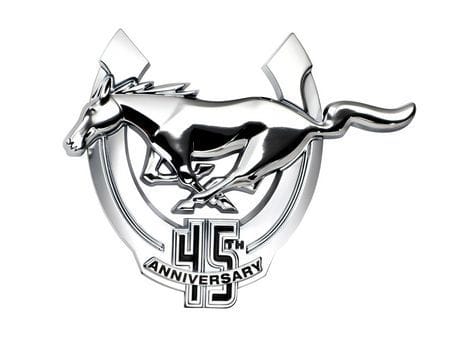Today marks the 45th anniversary of the original pony car and the longest running nameplate in the history of Ford Motor Company.
April 17, 1964
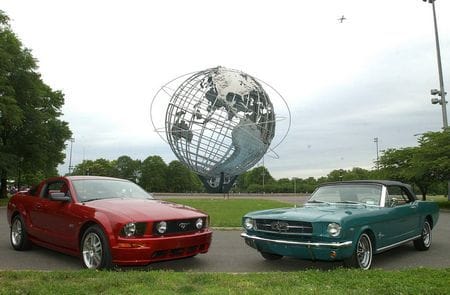
You had to be there to appreciate it. The unveiling of the new Ford Mustang at the New York World’s Fair marked a watershed moment in the car industry. Up until this day, sports cars (hey, “sporty” was real close to “sports” when you were in junior high school) were reserved for those who had a lot of money (Thunderbird, Corvette), were mechanically inclined (MG, Triumph), or both (Jaguar, Porsche, Ferrari).
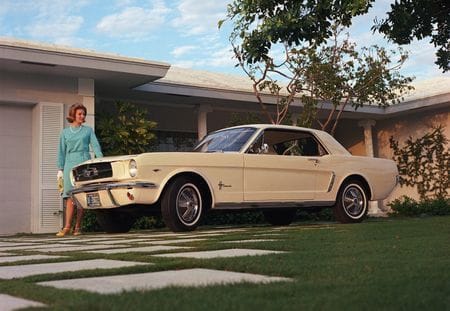
Not only did the Mustang look cool, you could comfortably fit a family of four into it and the base price was just $2320.96. It was so affordable that many families became multiple Mustang households.
Early history
As we noted in previous articles, the Mustang’s early years were nothing short of phenomenal. Ford had originally gauged sales at an estimated rate of 100,000 units, annually. That figure had to be quickly revised as first-day orders came to an astounding 22,000. Ford eventually sold 417,000 Mustangs in the first 12 months and reached the million sales mark within 2 years.
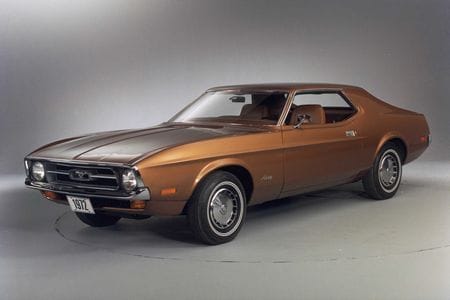
The middle years were somewhat less kind. The Mustang became ever larger; even through it was based on the same platform. By the time the Falcon-based car reached its last year, overall length was up by over a foot from the original car, while its weight had increased by over half a ton.
1974 saw the introduction of the Mustang II. But while many styling cues had been carried over from the original and sales took a sharp uptick, the Mustang II, although a bit more stylish than many of its competitors at the time had become just another small, underpowered coupe.
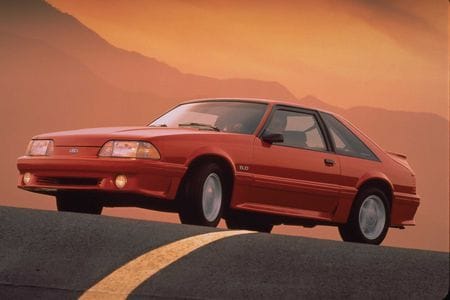
1979 marked the beginning of the third generation Fox-based Mustangs. In size, the new Mustang closely resembled the original. Its styling, however, was based on Ford’s new “Euro” look. Sales doubled from 1978 and, once again, placed the Mustang ahead of its rival, the Chevrolet Camaro.
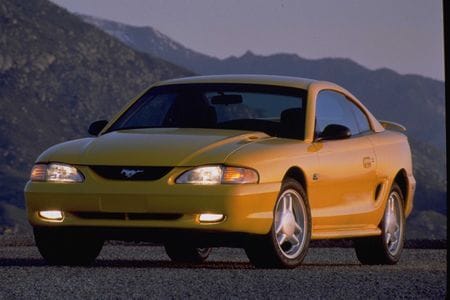
Fourth generation 1994-2004
Although the 1994 Mustang was still based on Ford’s Fox platform, it was an updated and re-engineered version. Mustang aficionados who had waited 15 years for a redesign weren’t disappointed. The new car borrowed several design cues from the original car. The new generation was as sleek as the old one had been boxy. The traditional “pony” logo floated in the center of the new grill with the entire front end evoking the vintage Mustang. Meanwhile, side scoops once again adorned the center of the rear quarter panel just in front of the wheel arch.
In back, the three taillamps (as on the original) on each side were split horizontally (this was changed in 1997 to the original vertical design and the individual lights were moved further apart). A steeply raked windshield and short rear deck completed the retro-themed package.

The fourth generation also marked a resurgence in fabled Mustang performance. Engine choices initially ranged from a 145 horsepower 3.8 liter V-6 to a 5.0 liter V-8 that produces 240 horsepower. By 1998, three engines were available with the V-6 now putting out 150 horsepower and the SVT Cobra 4.3 liter V-8 producing 305 horsepower.

In 1999, Ford reskinned the Mustang to reflect its “New Edge” styling. The round corners of the previous generation were replaced by more angular styling and the side scoop trim was larger and more pronounced. In back, a new fascia featured three distinct vertical rectangular taillamps on each side. The SVT Mustang Cobra was also the first Mustang with an independent rear suspension and its 4.6 liter V-8 produced 320 horsepower. 2000 also saw the first Mustang Bullitt GT, honoring the 1968 Mustang GT 390 driven by Steve McQueen in one of the most famous movie chase scenes ever filmed.
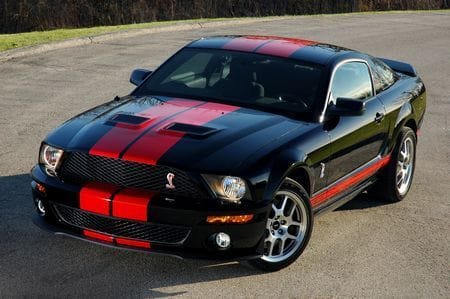
Fifth generation 2005-2009
Based on Ford’s all-new DC2 platform, the latest-generation Mustang draws even more design cues from the original – especially the 67-68 models. Retro round outboard headlights frame a center grill with a floating “pony” logo. From the side, wheel arches are more pronounced, but the side scoop is more muted – much like the original ’64. The coupe model features a rear quarter window very reminiscent of the original Shelby GT 350, while the three vertical taillamps are vintage Mustang.
.jpg)
In 2008, the Mustang reached a milestone as the 9 millionth Mustang – a GT convertible – was built. 2008 also marked the return of the Bullitt edition. By this time, powertrains ranged from the 4.0 liter V-6 to a 5.4 liter DOHC supercharged V8 on the GT that produced 500 horsepower in standard form and 540 horsepower for the GT 500KR (king of the road) edition. To mark the last year of the current body style in 2009, Ford offered a unique glass roof option.
.jpg)
2010 Redesign
The 2010 redesigned Mustang was unveiled in Los Angeles on November 18, 2008. Based on the same DC2 platform, the new design gives the pony car a much leaner appearance as well as better aerodynamics. A new headlight design includes integrated turn signals, while the hood features a prominent “powerdome”. In back, the trunk no longer has a keyhole and there is a revised 3-lens taillamp with LEDs that blink in sequence, much like earlier Thunderbird and Mercury Cougar models.
.jpg)
Inside, softer surfaces on the dashboard and door panels are complimented by real aluminum trim as well as fewer trim parts for the dashboard, thus ensuring a quieter ride.
![]()
Epilogue
The past 45 years have been a wild ride for the Mustang. From its initial sales success in the 1960’s, it has grown to iconic status in the automotive industry. Reflected in the history of the Mustang is much of the good and not so good that has happened to America since April of 1964.
The late sixties and early seventies saw the Mustang play an integral part of the pony car era as it took part in the horsepower wars that were staged on the main streets of many American towns.
The early seventies also saw the oil embargo as well as an increased awareness of the environment and both took their toll on the Mustang. Horsepower was strangled by emissions controls and the Mustang, itself, was downsized. As the industry began to adapt, computers aided in car design while electronics were used in engine management systems to increase horsepower while decreasing emissions at the same time.
The first Mustang to take advantage of this was the ’79 model. And as the baby boom generation continued to age, those belonging to it began to look for things in the present that reflected the best of what they remembered from the past and the Mustang was there for them, as well. It started with the retro ’94 redesign and continued through the 2005 to the new 2010 Mustang.
So from all of us here at LotPro.com, we would like to wish a very happy anniversary to the Mustang for giving us 45 very good years.
